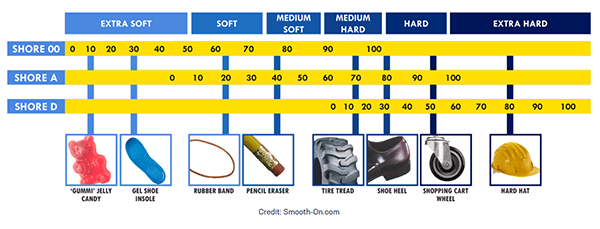Shore hardness is a measure of the hardness of different materials, and measures the resistance of a material to indentation.
If you are using material such as a TPE for your project, knowing a shore hardness will aid in sourcing a material that can be used for the application required.
THE SHORE HARDNESS SCALE
There are 3 Shore Hardness Scales – Shore 00, Shore A and Shore D. Shore 00 measures rubbers and gels that are very soft, like a gel insole. The Shore A Hardness Scale measures the hardness of softer more flexible materials that range from very soft and flexible to extra hard with almost no flexibility at all. Semi-rigid plastics can also be measured on the higher end of the Shore A Scale at 90-95A. Shore A is the most commonly used scale. The Shore D Hardness Scale measures the hardness of hard rubbers, semi-rigid plastics and hard plastics, such as those used in a PVC Pipe. There are overlaps between the scales as seen below, a material with a hardness of A95 is also a Shore D50.

HOW IS A MATERIAL MEASURED?
To measure a material’s hardness, mainly rubber, elastomers and polymers, a Shore durometer is used. Depending on the scales that a material is being tested for, a different presser foot might be used. For Shore A, a flatter presser foot is used and for a Shore D, a more pointed presser foot is used. A Shore Durometer has a meter from 0-100 that it uses to record a reading. A sample is positioned straight and under the durometer. The durometer is pressed against the material until the flat metal plate is level with the sample. A higher result represents a higher resistance to indentation and therefore a higher number on the scale of hardness.




